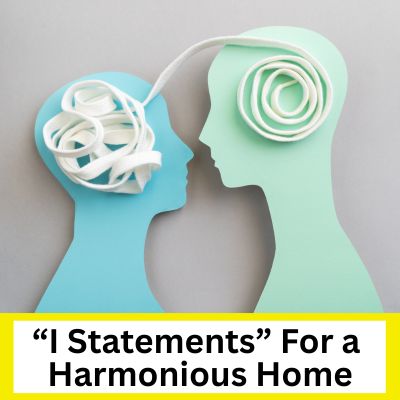“I Statements” For a Harmonious Home

When you live in a home with other people, it’s common for tensions to grow over clutter or household chores. Many people struggle to communicate their needs or frustrations with the people they live with. This often leads to more clutter and tension. Even if you live on your own, identifying your emotions and communicating your needs (even if just to yourself) can greatly help you let go of clutter and manage your home. Not knowing how to communicate clearly (either by avoiding conflict or rehashing your emotional wounds after a major blow-out) can also take you down a spiral of rumination, sabotaging your productivity and your peace (whether it be about clutter or something un-related). In this blog post, I’ll talk about not only how to use “I statements”, but how to respond when they’ve been used on you.
What Are “I Statements”?
“I statements” are statements that are used from the first person point of view to express an emotion. They are often paired with a statement that triggered the emotion, and a clarifying question or a request.
For example, “I felt disrespected when you walked with your dirty shoes across the floor that I had just cleaned.” After that, asking a question of clarity may help diffuse the situation before it escalates. “Did you know your shoes were dirty when you walked across the floor?” or “Did you know I had just cleaned the floor?”. The person clarifying their mistake might offer an apology and a commitment to do things differently next time. Or if they don’t you may need to communicate a clear request like “Could you please check your shoes before you walk inside?” or “How can you help me make sure this doesn’t happen again?”. At that point, the conversation may turn into brainstorming about how to avoid this in the future. However, using and responding to “I statements” is a sign of emotional maturity and skillful communication. Unfortunately, these skills are often not taught in schools. Many people never learn to communicate consciously in this way. It takes skill to be able to identify your emotions in the present and communicate them calmly, rather than reactively. It’s hard to be vulnerable, and talking about emotions puts someone into a state of vulnerability.
If you’ve communicated your emotions and triggers, and you’ve been met with:
- Defensiveness (excuses, or they start to attack back)
- Blame Shifting (justifying their behavior because of something you did, or shifting the blame onto someone else)
- Contempt or Passive-Aggressive Behavior (sarcasm, eye rolling, name calling, belittling statements, conveying hostility or resentment, etc)
- Stone Walling (the person you’re trying to communicate with just says “fine- we’ll do it your way!” in an aggressive tone, or they refuse to engage with the conversation).
- Criticism (“Well maybe if you weren’t so uptight, you wouldn’t care so much.)
- Dismissiveness (“It’s not that big of a deal”).
You are not alone! Not only does it take emotional maturity and good communication skills to deliver an “I statement”, it also takes skill to respond.
Why Is Good Communication Important?
“I statements” lower chance of defensiveness, promote collaboration, and encourage clarity and mutual respect. Good, healthy communication is important for not only couples, but family members, friends, co-workers, neighbors, acquaintances, etc. Bad communication fosters emotional distance and makes others feel disrespected. Good communication promotes emotional connection and mutual respect, which is the antidote for loneliness. Loneliness occurs when people don’t feel like they belong, or they feel dismissed, belittled, or like they don’t matter. Loneliness drives addictions like alcoholism, drug addiction, shopping addiction, and so many more unhealthy coping behaviors.
On the other hand, good communication makes people feel valued. When people feel safe and respected, they’re more likely to operate from their pre-frontal cortex, which is responsible for organization, impulse control, decision-making, and empathy- rather than their reactive amygdala (which is where the fight/flight/freeze/fawn response comes from).
The amygdala is the part of the brain you need when you’re faced with a real threat, such as being chased by a mountain lion, and it’s not meant to be activated all the time. When the amygdala is activated, you’ll find yourself in a very “reactive” state. Many people have a bad habit of spending too much time with their amygdala activated, and it’s hard for them to think clearly and calmly. Cultivating conscious communication is one of the skills needed to break the pattern of automatically letting the amygdala run the show rather than the more refined, advanced, and evolved part of the brain- the prefrontal cortex.
How to Use “I Statements”
Basic Formula:
“I feel [emotion] when [situation] because [reason or need]. I would appreciate [need or request.]
OR
- “When you [state observation]”
- “I feel or I think [state feeling/thought]”
- “…because [state reason]”
- “I would prefer that [state preference] or “Could you please [state request]
Step 1: Identify and communicate your feelings. Even if you can’t precisely identify exactly what emotion you’re feeling, just by labeling your feeling as “bad” can help slow the cycle of emotional reactivity. I like to use an Emotion Wheel to help me get clarity on what I’m feeling. Emotion wheels are cool because they show primary, secondary, and tertiary emotions. “I feel ___”. This is to clarify YOUR feelings, NOT what you feel like someone else is being. (“I feel like you’re being a jerk” is NOT what we’re going for! “I felt disappointed” is communicating an emotion).
Step 2: Identify when. What was the situation that triggered your feelings?
Step 3: Identify why. Why are you feeling that way?
Step 4: State your request or preference. What do you need?
Common Mistakes When Issuing “I Statements”
- Using “I feel” followed by a judgment: “I feel like you’re lazy”. (This is actually a disguised “you” statement, and comes off as blaming. Instead use: “I feel frustrated when chores are left undone because I value a tidy space. Could we please come up with a way to divide up the chores more fairly?”
- Skipping the emotion: “I feel that you never help”. This isn’t a feeling, it’s a criticism in disguise. Instead: I feel unsupported when I’m doing everything alone. Could you please help me by choosing some tasks that you’d like to do and commit to doing them?”
- Issuing a demand instead of a request: I feel annoyed, so you need to fix this now.” This shifts from expressing yourself to trying to control the other person. Instead: “I feel annoyed when I don’t get a heads-up about changes. Could you please discuss these things with me ahead of time?”
Responding To “I Statements”
Responding appropriately to “I statements” is important because it’s usually a vulnerable expression of someone’s feelings, needs, or boundaries. The appropriate way to respond involves active listening, validation, and a non-defensive attitude
- Listen without interrupting. Give your full attention. No eye-rolling, sighing, or preparing your rebuttal.
- Acknowledge and validate their feelings. Use reflective language, such as “it sounds like you’re feeling [upset, overwhelmed, etc].
- Resist the urge to correct, argue, or turn it back on them. Don’t say “well, I feel that way too!” or “you’re overreacting”.
- Ask clarifying questions (if needed).
- Take responsibility if applicable. If their “I statement” points to something you did, own it without defensiveness.
- Collaborate on a new way forward. Show you want to work together to avoid this conflict in the future.
Common Mistakes
- Dismissing their feelings
- Jumping into problem solving before validating
- Using sarcasm or humor to deflect
- Making it about you instead
What if You Don’t Agree?
If you hear an “I statement” that you don’t agree with (such as the facts, the interpretation, or the emotional impact), it’s still important to validate their experience without it invalidating your own perspective.
- Acknowledge their feelings, even if you see it differently. You don’t have to agree with their version of events to respect how they feel.
For example: “I can see that this really upset you.”
- Avoid defensiveness or correcting their feelings. It’s tempting to say things like “that’s not what happened” or “you’re over-reacting”, but this usually just escalates things. Instead, you could say “I had a different experience, but I want to understand where you’re coming from.”
- Share your perspective using your own “I statements.” Once you’ve acknowledged theirs, you can express your side without negating theirs. For example, “I hear you felt scared. I didn’t realize that at the time- I thought I was doing the right thing. I’m sorry it came across that way. (Don’t say “I’m sorry you feel that way”. It avoids accountably, is dismissive, condescending, and lacks empathy.)
- Look for a way forward. Even if you disagree, you can usually agree on the importance of the relationship and a desire to improve healthy communication.
Avoid Saying
- “That’s not true.”
- “That’s your problem, not mine.”
- “You always take things the wrong way.”
- “I didn’t do anything wrong.”
Emotional Maturity
It takes time to develop the emotional maturity and awareness to be able to use “I statements” with fluency and proficiency. If you’re finding it’s kind of clunky and unnatural at first, that’s perfectly normal. I always appreciate when someone tries to communicate their feelings or boundaries, even if it comes off as harsh or abrasive, because I know how hard it is to be vulnerable. So, as you’re building your skills, remember to use grace with yourself and with others who haven’t mastered these skills yet.
Signs You’re Dealing with Someone with Emotional Immaturity
- They’re quick to get defensive. No matter how carefully you’ve crafted your statement, or how gentle your tone is, everything feels like an attack to them. They will argue, shut down, or turn their back on you. Mature people know how to hear feedback without becoming defensive.
- They deflect blame. They don’t take accountability for their words or actions, and will blame others, twist the story, or will change the subject. They can’t handle being wrong. Emotionally mature people can take accountability without collapsing under shame or guilt.
- They guilt trip. They don’t clearly ask for what they want, but they want you to feel bad. It’s not about communication, it’s about control. Emotionally mature people can clearly ask for what they need, clearly and calmly- no strings attached.
- They’re passive aggressive. They don’t communicate clearly, but may slam doors, use sarcasm, or act really cold. It’s their way of expressing negative emotions without putting themselves in a vulnerable state that may result in rejection. Emotionally mature people say what’s wrong out loud.
- They weaponize their emotions. Rather than crying or venting in an authentic way, they do it to pressure the other person to do what they want them to do, or to get their way. Emotionally mature people ask for what they want directly, without manipulating others.
Examples That Relate to Home Organization
- When someone leaves clutter in shared spaces: “I feel overwhelmed when the kitchen counter is covered with stuff because it makes it hard for me to relax or cook. Can we please work on a system to keep it clear?
- When you want to declutter but someone is hesitant: “I feel stuck when I try to let go of things and we disagree about what to keep because I want our space to feel more manageable. Can we please talk about what matters most to both of us?”
- Setting boundaries in your own space: “I feel anxious when others move things in my office without asking because I rely on that space to be organized a certain way. Could you please check in with me before making any changes?”
- Encouraging shared responsibility: “I feel burnt out when I’m the only one putting things away because I want the home to be a shared responsibility. Could we talk about a plan so that everyone is pitching in more regularly?”
Avoiding “You Statements”
- Instead of: “You never do your dishes!” Try: “I feel stressed when there are so many dishes in the sink. Could we please alternate who does the dishes everyday?”
- Instead of: “You didn’t take the trash out like you promised!” Try: I felt annoyed when you didn’t take the trash out. Could you please set a reminder so that you remember to do it next time?”
- Instead of: “You don’t care about the cleanliness of the house!” Try: I feel overwhelmed when I have so many chores to do, and you’re out with your friends. Could we please talk about how we can split up the chores and get them done together so we both have a chance to go out with our friends?”
What to Do If Someone Is Still Defensive When Being Issued “I Statements”
- Stay calm and grounded. Don’t escalate. Stay calm with your tone and body language. Just because they are getting defensive, it doesn’t give you permission to get reactive.
- Remind yourself- you’re modeling healthy communication, even if they’re not ready to meet you there.
- Gently acknowledge the defensiveness. For example, you could say, “I can tell this feels uncomfortable to talk about. That’s ok- we don’t have to figure it all out at once.” Or “I’m not trying to attack you- I just wanted to share how I’m feeling.”
- Reaffirm your intention of trying to connect, not criticize. “I want to work with you to find a solution that works for both of us.”
- Pause the conversation if needed. Protect your peace, and give them space to process. Agree to take a break and pick the conversation back up later.
- Reflect on the pattern. If defensiveness is a regular response, even to respectful, thoughtful communication, ask yourself: Is this person emotionally mature enough to have these conversations? Do they have the skills to regulate their own discomfort? Is this a safe and reciprocal relationship?
- Focus on what you can control. You can’t force someone to receive your words well, but you can continue practicing speaking from your experience, asking clearly for what you need, and setting boundaries when necessary.
Be Compassionate with Yourself
I am certainly NOT an expert at using “I Statements” or clearly expressing my emotions and needs, however, I know how important it is. I greatly admire people who have these skills down pat. I hope to be there someday. But the only way to get there is to practice and to learn from mistakes. If you try to communicate clearly and you mess up, don’t give up. Acknowledge what you did right, and what didn’t go so well. Reward your effort, even if it’s clunky and you get sucked into reactivity, blame, use “you statements”, you get defensive, or whatever mess you make. Hopefully you learn from your mistakes and have forgiving people in your life that understand that healthy communication is a skill to be learned. We are all in this together!

Posted By Jean Prominski, Certified Professional Organizer
- Follow me on Instagram @seattlesparkle
- Join my Facebook Group, Declutter and Organize with Seattle Sparkle.
- Ready to book a consultation? Complete this form.




